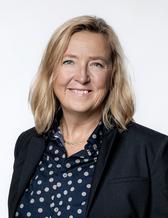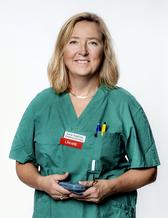- Home
- Research
- Find research
- Karin Sundfeldt, professor with female health in focus
Karin Sundfeldt, professor with female health in focus
She is a cancer researcher and gynecologist, enthusiastic about translational research and networking. Over the years, this combination has proved especially favorable and successful. In 2011, she also became a professor of obstetrics and gynecology, which has brought new challenges. Who is she and what have these first 10 years meant?

Karin Sundfeldt grew up in Stockholm with dreams of a creative career in theater or journalism, but in the end her ardent interest in nature and biology won the day. In 1985, she was admitted to the Medical Program in Gothenburg — a city she had no relationship with at all, in fact.
She stayed and made her career here. In 2011, she was appointed an adjunct professor of obstetrics and gynecology at the University of Gothenburg. In 2019, in competition, she secured the professorship associated with a position as consultant in gynecology at Sahlgrenska University Hospital.
She describes herself as extremely curious and stubborn — a combo that tends to be quite time-consuming but is good for a researcher.
“The curiosity makes you think about how things are and want to start new projects to find answers. And the stubbornness makes me finish what I’ve started. They’ve been good qualities in my roles as a researcher and doctor,” Sundfeldt says.
Women’s hormonal system affects their whole life cycle
Early in her medical training, she became fascinated by reproductive physiology and the female endocrine (hormonal) system, which so strongly affect women’s lives. Her path to becoming a gynecologist began when she started her doctoral studies at the Department of Endocrinology, part of the Institute of Neuroscience and Physiology at Sahlgrenska Academy. Her research area was how the ovaries function, not at organ level as she first planned, but at the molecular biological level. The focus was on cell–cell adhesion — the proteins that hold cells together, and what regulates these proteins in connection with the ovulatory process.
“On top of my medical training, I added five-year doctoral studies in molecular biology and ovarian physiology, which I found really exciting and enjoyable. We used the very latest molecular biology techniques that existed in the ’90s to study ovulation, folliculogenesis and the corpus luteum. We also looked at what controlled the expression of the individual proteins that hold the cells together.”
Cancer cells change shape to spread more easily
She then proceeded to look at the environment outside the cells, which deepened her interest in cancer. This was because the cell–cell bonds change when cancer cells develop and then metastasize, and adjacent supporting tissue can be invaded.
While pursuing further studies as a gynecologist, she secured funds of her own and was able to host her own doctoral students. Together, they explored how cancer cells change shape to facilitate their migration and growth in distant parts of the body, and how they differ from healthy cells. New technological advances, and thus new methodologies, enabled the quest for new, measurable biomarkers for cancer detection. Establishing biobanks therefore also became a vital source of new research, in which Karin has been closely involved.
“By both using our well-functioning cancer registers and maintaining the tiptop quality of the biobanks, we can make great progress locally. But we can also join in larger networks, plus national and international collaborations, to step up the pace and answer our questions faster".
Ovarian cancer hard to detect and screening method still lacking
The focus on ovarian cancer tumor biology persisted and she was involved when the Sahlgrenska Center for Cancer Research (SCCR) was set up in 2010. Ovarian cancer, which affects roughly 700 women a year in Sweden alone, is the deadliest of the gynecological forms of cancer. The earlier we can diagnose or even prevent ovarian cancer, the more women will survive. Cervical cancer is often detected early thanks to the screening program initiated in the 1970s. As yet, there is no screening method for ovarian cancer and it usually causes symptoms only at a late stage, when it has already spread, which makes it harder to cure. Once unclear changes in the ovaries are detected through ultrasound, many women— about one in five cancer cases — are operated on “for safety’s sake.” This not only represents an unnecessary surgical risk for these women, but also involves hormone loss if their ovaries are removed.
“We need greater diagnostic accuracy. There’s a huge demand for a simple blood test that distinguishes unclear cases from women with cancer. In a newly published study, along with Uppsala researchers, we’ve developed a biomarker experiment with 11 proteins that differ between healthy and sick individuals. We want to operate on the right women, while not missing anyone with a tumor disease.”
Early detection of ovarian cancer using nanoparticles
She is collaborating with scientists in Finland on the same task: making established biomarkers more responsive.
“With a new form of nanoparticle-assisted analysis of individual sugars on cancer antigen 125 (CA 125), we can already find ovarian cancer with great certainty, even in early stages".
“We’ve also been involved in demonstrating that, in addition, the samples taken from the woman during cervical screening, a type of liquid biopsy, can show traces of cancer DNA from both uterine and ovarian cancer. The tumor cells and DNA have then been transported through the fallopian tube and uterus to the cervix, where they can be detected in tiny quantities thanks to newly developed, hypersensitive DNA sequencing techniques based on RNA and DNA.”
Karin has just been awarded SEK 4 million by the Sjoberg Foundation to speed up the pace at which this analytical technique can be developed, and its diagnostic safety validated.
“Although all the above advances must be evaluated in new studies, I think they include three outstanding examples of good translational research that can quickly become significant in everyday clinical practice.”

Chance to influence the working day — conducive to research advances
“I’ve been working as a professor for 10 years now. Initially, it didn’t make that much of a difference. But the opportunity to spend more time thinking and writing has been crucial for the ability to compile and publish our results. And with that comes the scope for applying for and attracting more research grants so that my group can grow".
“In clinical work, you know where you should be every hour of the day, while I’m in control of the days for research work and decide how intensively to pursue it. It’s a great ‘freedom under responsibility’ that suits me.”
Despite her professorship, Karin continued with her clinical work, spending some 50–60% of her time on reception, on-call duties, and surgery, but she reduced it to 30% in 2019. She believes that clinical work is a key part of her professional practice as a doctor, and that it also creates balance and keeps the research she does solidly based on reality.
Confidence and contribution to future development
She says that, over the years, working with translational research has proved especially favorable and successful. This is because when issues from the clinical hospital environment are addressed through basic research, interesting new angles on the theories arise. And we can use the new technique to solve the research questions.
She also wants to highlight the never-ending need for trust and grants.
“I’ve received many grants over the years and always had the feeling that someone trusted in my ideas and what I’ve wanted to build up. That’s felt important. When I lecture to the young graduate research students, I usually talk about the importance of enjoying oneself at work, always being curious but also persistent. It’s especially important to keep at it — getting published, showing one’s research, attracting attention, and being able to apply for money. Getting funding is the only way to become independent and carry on doing the research you yourself believe in.”
What are your plans from now on?
“First, to keep pushing for better diagnostics and screening for gynecological cancer. And in January 2021, within the highly specialized care framework of the Swedish National Board of Health and Welfare, we’re going to be able to start a hub for radical endometriosis surgery — one of just four units in Sweden.”
This will mean not only centralized, high-quality surgical treatment for the individual women with severe endometriosis. Now, the researchers obtained a unique opportunity to consolidate research concerning this severe disease.
In the Academy, she has had more responsibility for teaching issues for about a year now. This was a new challenge, and one also affected by the pandemic.
“Besides COVID-19, which has involved major changes to digital teaching and course modules, in the past few years I’ve been engaged in planning and preparing for the new six-year training that fully qualifies you as a medical practitioner.”
Text: Susanne Lj Westergren
Age: 58
Lives in: Torslanda
Family: Mikael, 40,000 bees and three children who have left the nest.
Hobbies: All kinds of outdoor activity, skiing, cycling, the sea and the garden.
Inspired by: family and friends.
Motto: Be curious, trust your inner compass and have fun.
- Karin Sundfeldt’s personal GU page
- SCCR and the Karin Sundfeldt Group